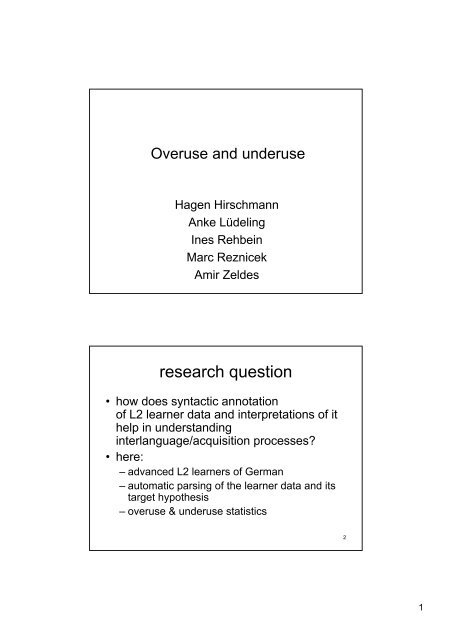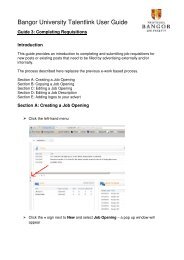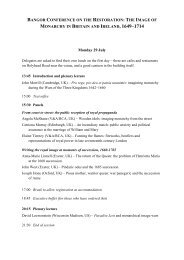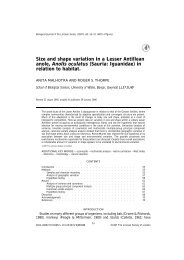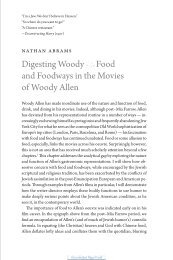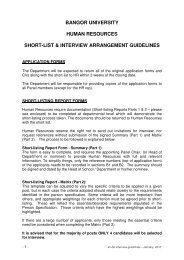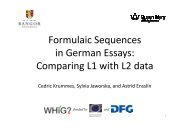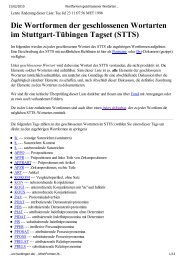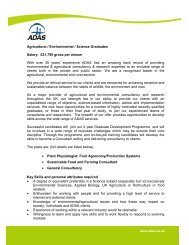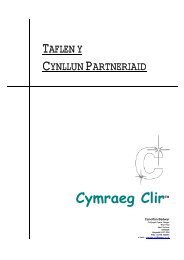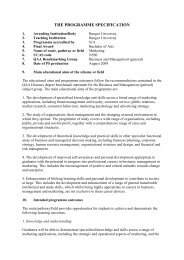Overuse-underuse on syntactic annotation of Falko
Overuse-underuse on syntactic annotation of Falko
Overuse-underuse on syntactic annotation of Falko
Create successful ePaper yourself
Turn your PDF publications into a flip-book with our unique Google optimized e-Paper software.
<str<strong>on</strong>g>Overuse</str<strong>on</strong>g> and <str<strong>on</strong>g>underuse</str<strong>on</strong>g><br />
Hagen Hirschmann<br />
Anke Lüdeling<br />
Ines Rehbein<br />
Marc Reznicek<br />
Amir Zeldes<br />
research questi<strong>on</strong><br />
• how does <strong>syntactic</strong> annotati<strong>on</strong><br />
<strong>of</strong> L2 learner data and interpretati<strong>on</strong>s <strong>of</strong> it<br />
help in understanding<br />
interlanguage/acquisiti<strong>on</strong> processes?<br />
• here:<br />
– advanced L2 learners <strong>of</strong> German<br />
– automatic parsing <strong>of</strong> the learner data and its<br />
target hypothesis<br />
– overuse & <str<strong>on</strong>g>underuse</str<strong>on</strong>g> statistics<br />
2<br />
1
ackground: interlanguage<br />
• assumpti<strong>on</strong>: learners <strong>of</strong> a sec<strong>on</strong>d/foreign<br />
language have a systematic internal grammar<br />
(interlanguage), different from the internal<br />
grammar <strong>of</strong> L1 speakers <strong>of</strong> the target language<br />
• interlanguage is influenced by<br />
– the learners' L1 (transfer, interference)<br />
– the structure <strong>of</strong> the L2<br />
– general learning principles<br />
– mode <strong>of</strong> acquisiti<strong>on</strong> / teaching method / learning<br />
strategies<br />
• Selinker (1972), Nickel (1998) and many others<br />
3<br />
interlanguage & data<br />
• further assumpti<strong>on</strong>: interlanguage can be<br />
researched through the analysis <strong>of</strong> (naturally<br />
occurring) learner data<br />
• <strong>on</strong>e type <strong>of</strong> data: learner corpora<br />
• analysis<br />
– error analysis<br />
→ analysis <strong>of</strong> learner data wrt a 'correct' form<br />
– c<strong>on</strong>trastive interlanguage analysis (CIA)<br />
→ analysis <strong>of</strong> the learner data wrt to another corpus<br />
4<br />
2
interlanguage & data<br />
• further assumpti<strong>on</strong>: interlanguage can be<br />
researched through the analysis <strong>of</strong> (naturally<br />
occurring) learner data<br />
• <strong>on</strong>e type <strong>of</strong> data: learner corpora<br />
• analysis<br />
– error analysis<br />
→ analysis <strong>of</strong> learner data wrt a 'correct' form<br />
– c<strong>on</strong>trastive interlanguage analysis (CIA)<br />
→ analysis <strong>of</strong> the learner data wrt to another corpus<br />
5<br />
plan<br />
• annotati<strong>on</strong> <strong>of</strong> learner corpora<br />
• overuse and <str<strong>on</strong>g>underuse</str<strong>on</strong>g> statistics<br />
• analysis <strong>of</strong> parsed learner data<br />
6<br />
3
plan<br />
• annotati<strong>on</strong> <strong>of</strong> learner corpora<br />
• overuse and <str<strong>on</strong>g>underuse</str<strong>on</strong>g> statistics<br />
• analysis <strong>of</strong> parsed learner data<br />
10<br />
annotati<strong>on</strong> <strong>of</strong> learner data: format<br />
• many learner corpora are not annotated<br />
• some are annotated with error tags, usually<br />
tabular formats or tree formats (XML), typically<br />
not stand<strong>of</strong>f, typically not amendable by the user<br />
• some (few) are annotated <strong>on</strong> other levels (pos,<br />
lemma etc.)<br />
• <strong>Falko</strong>: stand<strong>of</strong>f format (token annotati<strong>on</strong>, span<br />
annotati<strong>on</strong>, graphs, pointers etc.), annotati<strong>on</strong><br />
layers can be freely added<br />
• Lüdeling et al. (2005)<br />
11<br />
4
annotati<strong>on</strong> <strong>of</strong> learner data:<br />
c<strong>on</strong>ceptual issues<br />
• annotati<strong>on</strong> <strong>of</strong> learner data is highly problematic<br />
– data is unsystematic (especially if there are different<br />
L1s) – difficult for automatic tools<br />
– for error analysis and c<strong>on</strong>trastive interlanguage<br />
analysis: data has to be interpreted (l<strong>on</strong>g discussi<strong>on</strong><br />
in acquisiti<strong>on</strong> research)<br />
• Corder (1981), Izumi/Uchimoto/Isahara (2005),<br />
Tenfjord/Hagen/Johansen (2004), Diaz-Negrillo<br />
et al. (2010) etc.<br />
12<br />
annotati<strong>on</strong> <strong>of</strong> learner data:<br />
target hypothesis<br />
• c<strong>on</strong>sider: An der anderen Seite, wenn da<br />
kein Feminismus wäre, stünden wir noch<br />
nur in der Küche und köchten wir.<br />
(fkb034_2008_07)<br />
~ "On the other hand, if there were no<br />
feminism, we would still <strong>on</strong>ly stand in the<br />
kitchen and cook."<br />
13<br />
5
annotati<strong>on</strong> <strong>of</strong> learner data:<br />
target hypothesis<br />
• c<strong>on</strong>sider: An der anderen Seite, wenn da<br />
kein Feminismus wäre, stünden wir noch<br />
nur in der Küche und köchten wir.<br />
(fkb034_2008_07)<br />
~ "On the other hand, if there were no<br />
feminism, we would still <strong>on</strong>ly stand in the<br />
kitchen and cook."<br />
14<br />
annotati<strong>on</strong> <strong>of</strong> learner data:<br />
target hypothesis<br />
• all error tags depend <strong>on</strong> an (at least implicit)<br />
correct versi<strong>on</strong> <strong>of</strong> a learner utterance<br />
→ target hypothesis<br />
• <strong>Falko</strong>: explicit target hypotheses<br />
• <strong>of</strong>ten there are several ways <strong>of</strong> correcting an<br />
utterance<br />
th1: Auf der anderen Seite, wenn da kein<br />
Feminismus wäre, stünden wir nur noch in der<br />
Küche und kochten.<br />
th2: Andererseits stünden wir, wenn es keinen<br />
Feminismus gäbe, nur noch in der Küche und<br />
kochten.<br />
15<br />
6
annotati<strong>on</strong> <strong>of</strong> learner data:<br />
target hypothesis in <strong>Falko</strong><br />
• th1: sentence-based, very close to original text,<br />
mainly clear grammatical errors<br />
• th2: text-based, also stylistic errors<br />
• the differences between a target hypothesis and<br />
the original data is automatically annotated with<br />
edit tags (change, insert, replace etc.)<br />
• all layers are automatically annotated with pos<br />
tags & lemma (TreeTagger, Schmid 1994)<br />
• additi<strong>on</strong>ally – manual error tags for some<br />
phenomena<br />
16<br />
target hypotheses …<br />
• are just as necessary for L1 data, btw<br />
18<br />
7
plan<br />
• annotati<strong>on</strong> <strong>of</strong> learner corpora<br />
• overuse and <str<strong>on</strong>g>underuse</str<strong>on</strong>g> statistics<br />
• analysis <strong>of</strong> parsed learner data<br />
21<br />
research questi<strong>on</strong><br />
• we want to find structural problems in<br />
German L2 interlanguage<br />
• structural problems are those problems that<br />
– occur independent <strong>of</strong> the learners' L1<br />
– and are therefore attributed to the structure <strong>of</strong><br />
the target grammar<br />
22<br />
8
how can we detect acquisiti<strong>on</strong><br />
problems?<br />
• structures that are unique for the L2 or<br />
different from the learners' L1s (transfer)<br />
• structures that are judged to be difficult by<br />
the learners<br />
• structures that c<strong>on</strong>tain many errors<br />
• <str<strong>on</strong>g>underuse</str<strong>on</strong>g>d structures<br />
23<br />
<str<strong>on</strong>g>underuse</str<strong>on</strong>g><br />
• L2 distributi<strong>on</strong>s are compared to L1 distributi<strong>on</strong>s<br />
• overuse, <str<strong>on</strong>g>underuse</str<strong>on</strong>g> are defined as (statistically<br />
significant) differences between the varieties<br />
• a category can be <str<strong>on</strong>g>underuse</str<strong>on</strong>g>d in L2 because<br />
– the learners do not know it<br />
– the learners do know it but (unc<strong>on</strong>sciously) avoid it<br />
26<br />
9
<str<strong>on</strong>g>underuse</str<strong>on</strong>g><br />
• L2 distributi<strong>on</strong>s are compared to L1 distributi<strong>on</strong>s<br />
• overuse, <str<strong>on</strong>g>underuse</str<strong>on</strong>g> are defined as (statistically<br />
significant) differences between the varieties<br />
• a category can be <str<strong>on</strong>g>underuse</str<strong>on</strong>g>d in L2 because<br />
– the learners do not know it<br />
– the learners do know it but (unc<strong>on</strong>sciously) avoid it<br />
→ a diagnostics for detecting structural acquisiti<strong>on</strong><br />
problems<br />
27<br />
visualizati<strong>on</strong> <strong>of</strong> overuse and<br />
<str<strong>on</strong>g>underuse</str<strong>on</strong>g><br />
• <str<strong>on</strong>g>underuse</str<strong>on</strong>g>: cold colours<br />
• overuse: warm colours<br />
• intensity <strong>of</strong> colour signals strength <strong>of</strong><br />
overuse/<str<strong>on</strong>g>underuse</str<strong>on</strong>g><br />
Underuse<br />
<str<strong>on</strong>g>Overuse</str<strong>on</strong>g><br />
• Excel add in by Amir Zeldes available at<br />
http://korpling.german.hu-berlin.de/~amir/uoaddin.htm<br />
28<br />
10
visualizati<strong>on</strong> <strong>of</strong> overuse and <str<strong>on</strong>g>underuse</str<strong>on</strong>g>:<br />
lexical categories<br />
lemma tot_norm de da en fr pl ru<br />
in 0.013188 0.012261 0.014041 0.014247 0.015272 0.012135 0.009534<br />
es 0.010897 0.011945 0.010900 0.011379 0.013347 0.008163 0.012385<br />
sie 0.010618 0.008193 0.010643 0.008835 0.010909 0.006067 0.005613<br />
man 0.010164 0.007900 0.012438 0.008742 0.009754 0.006950 0.007306<br />
dass 0.009522 0.007404 0.012823 0.008789 0.009625 0.008880 0.009890<br />
v<strong>on</strong> 0.007982 0.007122 0.007309 0.006846 0.007315 0.010259 0.007930<br />
auch 0.007028 0.008362 0.008527 0.005828 0.005775 0.005461 0.004455<br />
für 0.006683 0.007201 0.006091 0.007216 0.006802 0.005736 0.004188<br />
sind 0.006465 0.004271 0.008976 0.007308 0.006930 0.004964 0.005346<br />
sich 0.006309 0.011697 0.006283 0.006291 0.006930 0.007170 0.005435<br />
ich 0.006262 0.003877 0.013272 0.005366 0.003465 0.001434 0.001426<br />
aber 0.006048 0.003347 0.007309 0.006245 0.007315 0.003365 0.003831<br />
sich (reflexive pr<strong>on</strong>oun) is <str<strong>on</strong>g>underuse</str<strong>on</strong>g>d in all<br />
L1 groups<br />
29<br />
visualizati<strong>on</strong> <strong>of</strong> overuse and<br />
<str<strong>on</strong>g>underuse</str<strong>on</strong>g>: bigrams <strong>of</strong> pos-categories<br />
bigram tot_norm de da en fr pl ru<br />
$.-PPER 0.042384 0.005297 0.009748 0.007963 0.006166 0.005801 0.007409<br />
VVFIN-$, 0.042131 0.006457 0.00776 0.006343 0.006937 0.006243 0.008391<br />
PPOSAT-NN 0.041739 0.008058 0.007247 0.007269 0.007066 0.006298 0.005802<br />
ADV-ADV 0.041604 0.012858 0.010518 0.006111 0.006166 0.003094 0.002856<br />
ADV-APPR 0.039742 0.009117 0.008016 0.005324 0.007837 0.004807 0.004642<br />
PDAT-NN 0.03956 0.005409 0.004233 0.005509 0.007837 0.007735 0.008837<br />
ADV-ART 0.037125 0.007629 0.006349 0.006898 0.005653 0.006133 0.004463<br />
adverb chains are <str<strong>on</strong>g>underuse</str<strong>on</strong>g>d in all L1<br />
groups<br />
30<br />
11
<str<strong>on</strong>g>underuse</str<strong>on</strong>g> <strong>of</strong> adverbs<br />
• further research shows that<br />
– the pos tag ADV is not fine-grained enough:<br />
ADV should be divided into different <strong>syntactic</strong><br />
classes<br />
– these classes show different distributi<strong>on</strong>s<br />
– <strong>on</strong>ly some <strong>of</strong> these classes are <str<strong>on</strong>g>underuse</str<strong>on</strong>g>d by<br />
the learners<br />
• Hirschmann (2011, in preparati<strong>on</strong>)<br />
31<br />
strength <strong>of</strong> <str<strong>on</strong>g>underuse</str<strong>on</strong>g> <strong>of</strong> different<br />
<strong>syntactic</strong> ADV classes<br />
1<br />
1,1<br />
1,2<br />
1,3<br />
1,4<br />
1,5<br />
1,6<br />
1,7<br />
1,8<br />
1,9<br />
2<br />
PTK ADVV ADVS PTKM<br />
PTK: particles (sehr gut - very good)<br />
ADVV: modal adverbs (Bald schneit es – So<strong>on</strong> it will snow)<br />
ADVS: sentence adverbs (Bestimmt schneit es bald – Certainly, it will snow so<strong>on</strong>)<br />
PTKM: modal particles (Es schneit wohl gerade – It is ?apparently? snowing now)<br />
32<br />
12
<str<strong>on</strong>g>underuse</str<strong>on</strong>g> <strong>of</strong> adverb chains<br />
• the <strong>syntactic</strong> adverb classes were (manually) annotated<br />
(in essence this is a more fine-grained<br />
pos categorizati<strong>on</strong>)<br />
• many studies about adverbs in learner language –<br />
analysis purely lexical<br />
• the different distributi<strong>on</strong>s suggest that syntax might be<br />
relevant for understanding learner language<br />
• however, the <strong>syntactic</strong> informati<strong>on</strong> codable at token level<br />
is too limited: we need hierarchical relati<strong>on</strong>s<br />
(dependencies, c<strong>on</strong>stituents)<br />
• Möllering (2004), Vyatkina (2007) etc.<br />
33<br />
plan<br />
• annotati<strong>on</strong> <strong>of</strong> learner corpora<br />
• overuse and <str<strong>on</strong>g>underuse</str<strong>on</strong>g> statistics<br />
• analysis <strong>of</strong> parsed learner data<br />
34<br />
13
<strong>syntactic</strong> annotati<strong>on</strong> <strong>of</strong> learner<br />
corpora for acquisiti<strong>on</strong> research<br />
• many studies <strong>of</strong> <strong>syntactic</strong> phenomena in learner<br />
corpora, usually <strong>on</strong> the basis <strong>of</strong> surface<br />
structures (manually, pos tags, lexical cues etc.)<br />
for German see e.g. Diehl et al. (2000),<br />
Ahrenholtz (2008), Doolittle (2008), Breckle &<br />
Zinsmeister (submitted)<br />
• several (very few) parsed learner corpora, <strong>of</strong>ten<br />
not publically available<br />
Dickins<strong>on</strong> & Ragheb (2009), Rosén & de Smedt<br />
(to appear)<br />
35<br />
<strong>syntactic</strong> annotati<strong>on</strong> <strong>of</strong> learner<br />
corpora for CALL<br />
• parsing learner data would help in generating intelligent answers to<br />
learner errors in call systems – a lot <strong>of</strong> reserach in this area –<br />
usually not helpful for our research questi<strong>on</strong><br />
– <strong>of</strong>ten very restricted domains (questi<strong>on</strong> answering, fill in the blanks<br />
exercises etc.)<br />
– sometimes errors are explicitly introduced into 'native' data<br />
• another goal: making parsers robust against data errors –<br />
again not directly helpful for our research questi<strong>on</strong><br />
• still: interesting results wrt to parsing techniques / evaluati<strong>on</strong><br />
techniques etc.<br />
• Menzel & Schröder (1999), Vandeventer Faltin (2003), Ule & Simov<br />
(2004), Dickins<strong>on</strong> & Meurers (2005), Metcalf & Boyd (2006),<br />
Dickins<strong>on</strong> & Lee (2009), Amaral/Meurers/Ziai (2011) etc.<br />
36<br />
14
<strong>Falko</strong> – <strong>syntactic</strong> annotati<strong>on</strong><br />
• target hypothesis1 <strong>of</strong> L1 and L2 corpora<br />
• Berkeley parser<br />
• training data: 48473 trees <strong>of</strong> the TiGer treebank<br />
• preprocessing:<br />
– resolve crossing branches<br />
– merge GF labels with <strong>syntactic</strong> categories (NP-OA => NP_OA)<br />
• postprocessing<br />
– separate GF labels from <strong>syntactic</strong> categories<br />
• Brants et al. (2002), Kübler (2005), Kübler/Hinrichs/Meier (2006),<br />
Petrov & Klein (2008)<br />
37<br />
exemplary study about modifiers<br />
• further probes into the adverb <str<strong>on</strong>g>underuse</str<strong>on</strong>g><br />
– <str<strong>on</strong>g>underuse</str<strong>on</strong>g> statistics <strong>of</strong> <strong>syntactic</strong> categories:<br />
types <strong>of</strong> modificati<strong>on</strong><br />
– <str<strong>on</strong>g>underuse</str<strong>on</strong>g> statistics & a combined search over<br />
positi<strong>on</strong>s (fields), categories and functi<strong>on</strong>s<br />
(vorfeld)<br />
40<br />
15
analysis <strong>of</strong> <strong>syntactic</strong> annotati<strong>on</strong>:<br />
modifiers<br />
• certain <strong>syntactic</strong> classes <strong>of</strong> adverbs are<br />
<str<strong>on</strong>g>underuse</str<strong>on</strong>g>d<br />
• adverbs are <strong>syntactic</strong>ally analyzed as modifiers<br />
• research questi<strong>on</strong>:<br />
– is adverb <str<strong>on</strong>g>underuse</str<strong>on</strong>g> due to lexical properties <strong>of</strong> certain<br />
adverbs?<br />
do learners compensate for this <str<strong>on</strong>g>underuse</str<strong>on</strong>g> with other<br />
means <strong>of</strong> modificati<strong>on</strong>s (e.g. PPs)?<br />
– or do learners simply <str<strong>on</strong>g>underuse</str<strong>on</strong>g> modifiers (<strong>of</strong> any kind)<br />
(adverb <str<strong>on</strong>g>underuse</str<strong>on</strong>g> would then be a result <strong>of</strong> the<br />
general <str<strong>on</strong>g>underuse</str<strong>on</strong>g> <strong>of</strong> modifiers)?<br />
41<br />
overuse / <str<strong>on</strong>g>underuse</str<strong>on</strong>g> <strong>of</strong><br />
<strong>syntactic</strong> categories<br />
42<br />
16
overuse / <str<strong>on</strong>g>underuse</str<strong>on</strong>g> <strong>of</strong> <strong>syntactic</strong><br />
categories – significant results<br />
MO (modifier) is significantly<br />
<str<strong>on</strong>g>underuse</str<strong>on</strong>g>d in all L1s<br />
43<br />
modifier <str<strong>on</strong>g>underuse</str<strong>on</strong>g><br />
• check <strong>syntactic</strong> properties <strong>of</strong> MOs<br />
– what are the categories used for modificati<strong>on</strong>?<br />
– what is the target <strong>of</strong> the modificati<strong>on</strong>?<br />
modified<br />
element<br />
modificati<strong>on</strong><br />
(functi<strong>on</strong>)<br />
modifying<br />
element<br />
(filler)<br />
44<br />
but how <strong>of</strong>ten works out this [modal particle] ?<br />
17
modifier<br />
comparis<strong>on</strong> <strong>of</strong> modifiers in L2 and L1<br />
frequencies normalized per 1000 edges<br />
46<br />
modifier – results<br />
• categories <strong>of</strong> different complexity (lexemes<br />
to sentences) are used for modificati<strong>on</strong>;<br />
modificati<strong>on</strong> is frequent in L2 and L1<br />
• some categories are <str<strong>on</strong>g>underuse</str<strong>on</strong>g>d by the<br />
learners, <strong>on</strong>ly <strong>on</strong>e category is overused<br />
• adverbs, adverb phrases and adverbially<br />
used adjectives show the str<strong>on</strong>gest<br />
<str<strong>on</strong>g>underuse</str<strong>on</strong>g><br />
47<br />
18
modified element<br />
comparis<strong>on</strong> <strong>of</strong> modified elements in L2 and L1<br />
frequencies normalized per 1000 edges<br />
48<br />
modified element – results<br />
• all categories are frequently modified in<br />
both L1 and L2<br />
• but all <strong>syntactic</strong> relati<strong>on</strong>s possible for<br />
modificati<strong>on</strong> are <str<strong>on</strong>g>underuse</str<strong>on</strong>g>d<br />
• modifiers in adverbial phrases show the<br />
str<strong>on</strong>gest <str<strong>on</strong>g>underuse</str<strong>on</strong>g><br />
49<br />
19
MO – summary<br />
• the lexical ADV <str<strong>on</strong>g>underuse</str<strong>on</strong>g> is still visible<br />
• additi<strong>on</strong>ally, there is a purely <strong>syntactic</strong> effect:<br />
MO is structurally <str<strong>on</strong>g>underuse</str<strong>on</strong>g>d by the learners<br />
• further research: why is MO difficult?<br />
‣ semantics: now we would have to look at different<br />
semantic classes <strong>of</strong> modificati<strong>on</strong> (temporal, local, ….)<br />
– further research …<br />
‣ word order (topology): placement problems in the<br />
German middle field – further research<br />
‣ categorial effect: does the complexity <strong>of</strong> categories<br />
play a role?<br />
‣ ...<br />
50<br />
summary<br />
• all annotati<strong>on</strong> is interpretati<strong>on</strong><br />
‣ make interpretati<strong>on</strong> explicit and visible<br />
• for many research questi<strong>on</strong>s it is necessary to<br />
look at a combinati<strong>on</strong> <strong>of</strong> factors<br />
• <strong>syntactic</strong> annotati<strong>on</strong> helps us in finding<br />
acquisiti<strong>on</strong> patterns that combine lexical,<br />
categorial, topological and functi<strong>on</strong>al properties<br />
‣ multi-layer architecture, many formats, powerful<br />
search tools<br />
56<br />
20
Thank you!<br />
Danke!<br />
c<strong>on</strong>tact: anke.luedeling@rz.hu-berlin.de<br />
57<br />
21


